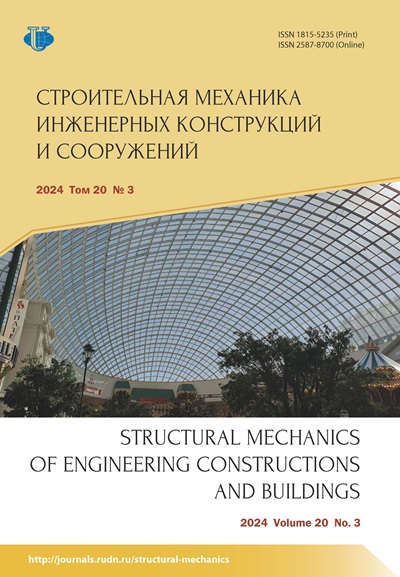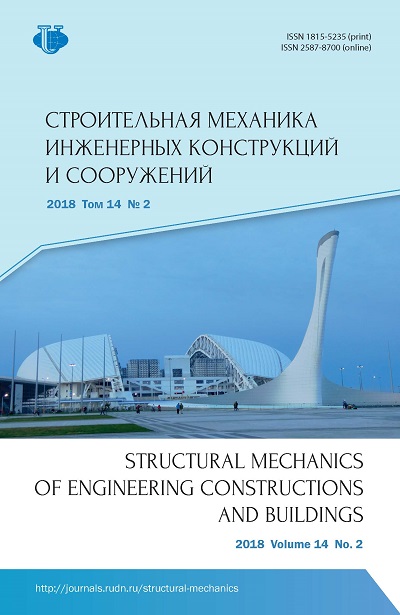Superposition principle as the fundamental error of the creep theory and standards of the reinforced concrete
- Authors: Sanzharovsky R.S1, Ter-Emmanuilyan T.N2, Manchenko M.M3
-
Affiliations:
- L.N. Gumilyov Eurasian National University
- Kazakh-British Technical University
- Krylov State Research Centre
- Issue: Vol 14, No 2 (2018)
- Pages: 92-104
- Section: Analysis and design of building structures
- URL: https://journals.rudn.ru/structural-mechanics/article/view/18644
- DOI: https://doi.org/10.22363/1815-5235-2018-14-2-92-104
Cite item
Full Text
Abstract
The errors in the foundations of the modern theory of creep of reinforced concrete caused by the use of the principle of superposition, which is an expansive interpretation of the principle (scheme) of the linear superposition of Boltzmann, are revealed and investigated. Extensive interpretation arises from the following circumstances: the phenomenon of aging of concrete; changes in the short-term properties of concrete with age τ at the time of its loading; nonlinearity of creep deformation, starting from the lowest loading levels; the use of “chain models” in the form of a series connection of several bodies, for example - the theory of Maslov, the theory of aging, a viscous element; addition of short-term properties of concrete to the properties of its creep; expanding interpretation of the compliance function for difference kernels. In the international norms of creep of reinforced concrete only linear creep of concrete and instantaneous linear properties are taken into account; their authors call their developments “a new advanced format developed in recent decades by international standards institutions”. However, these format estimates are erroneous. According to the Eurocode, a short-term diagram of concrete σ-ε has a descending section and a limited extent; and the floor-duchit of concrete is nonlinear. The founders of the theory are A.A. Gvozdev, N.Kh. Harutyunyan, S.V. Aleksandrovsky, P.I. Vasilyev - repeatedly indicate: “creep-concrete deformations are non-linearly dependent on stresses, starting from the lowest levels”. The results of the analysis published by the authors in the journal of Structural Mechanics of Engineering Constructions and Buildings No. 6 of 2017 and No. 3 of 2016 are supplemented. The article was written in accordance with the recommendations of the round table held in the RUDN University on June 9, 2016, under the direction of the D.Sc., prof. S.N. Krivoshapko.
About the authors
Rudolf S Sanzharovsky
L.N. Gumilyov Eurasian National University
Author for correspondence.
Email: stmj@rudn.university
Grand Ph.D., Prof., Principal Researcher, L.N. Gumilyov Eurasian National University. Research Interests: the development of the theory of creep of concrete with allowance for instantaneous and long-term nonlinearity, as well as their accounting in the calculations of structures
2 Satpaev St., Astana, 010008, Republic of KazakhstanTatyana N Ter-Emmanuilyan
Kazakh-British Technical University
Email: stmj@rudn.university
Doctor of Technical Sciences, Professor, Chief Researcher, KazakhBritish Technical University. Research Interests: development of new numerical methods for calculating of building structures, taking into account creep of materials
59 Tole Bi St., Almaty, 050000, Republic of KazakhstanMaxim M Manchenko
Krylov State Research Centre
Email: stmj@rudn.university
Ph.D, Senior Researcher, Krylov State Research Centre. Research Interests: creep of concrete taking into account instantaneous and long-term nonlinearity; strength of hull structures of vessels made of composite materials
44 Moskovskoe Shosse, St. Petersburg, 196158, Russian FederationReferences
- Chiorino M.A. Analysis of structural effects of time – dependent behavior of concrete: an internationally harmonized format // Concrete and Reinforced concrete – Glance at Future. III All Russian (International) Conference on Concrete and Reinforced Concrete, Moscow – 2014. Vol. 7, plenary papers, 338–350.
- Fib Model Code for Concrete Structures 2010, Ernst & Sohn, 2013, 402.
- ACI 209.3R-XX, Analysis of Creep and Shrinkage Effects on Concrete Structures, Final Draft, Chiorino M.A. (Chairm. of Edit. Team), ACI Committee 209, March 2011, 228 p.
- Sanjarovsky R., Manchenko M. Errors in the theory of creep of reinforced concrete and modern norms. Structural Mechanics of Engineering Constructions and Buildings. 2016. No 3. 25–32. (In Russ.)
- Sanjarovskiy, R., Ter-Emmanuilyan, T., and Manchenko, M. (2015) Creep of Concrete and Its Instant Nonlinear Deformation in the Calculation of Structures. CONCREEP 10: 238–247.
- Pars L.A. A treatise on Analytical Dynamics. Moscow: Nauka publ., 1971, 636. (In Russ.)
- Polzuchest' i usadka betona i zhelezobetonnyh konstrukcij. Sostoyanie problemy i perspektivy razvitiya [Creep and shrinkage of concrete and reinforced concrete structures. The state of the problem and prospects for development] / GOSSTROJ USSR; NIIZB. Moscow: Strojizdat publ., 1976, 351. (In Russ.)
- Sanzharovskij R.S, Manchenko M.M. (2017). Errors of international standards on reinforced concrete and rules of the Eurocode. Structural Mechanics of Engineering Constructions and Buildings. No 6, 25–36. (In Russ.)
- Veryuzhskij YU.V., Golyshev A.B., Kolchunov Vl.I., Klyueva N.V., Lisicin B.M., Mashkov I.L., Yakovenko I.A. Spravochnoe posobie po stroitel'noj mekhanike [Reference Book for Structural Mechanics]: v 2 t. T. I. Moscow: ASV publ., 2014, 506–508. (In Russ.)
- Rabotnov Yu.N. (1977). Elementy nasledstvennoj mekhaniki tverdyh tel [Elements of hereditary mechanics of solids]. Moscow: Nauka publ., 1977, 383. (In Russ.)
















